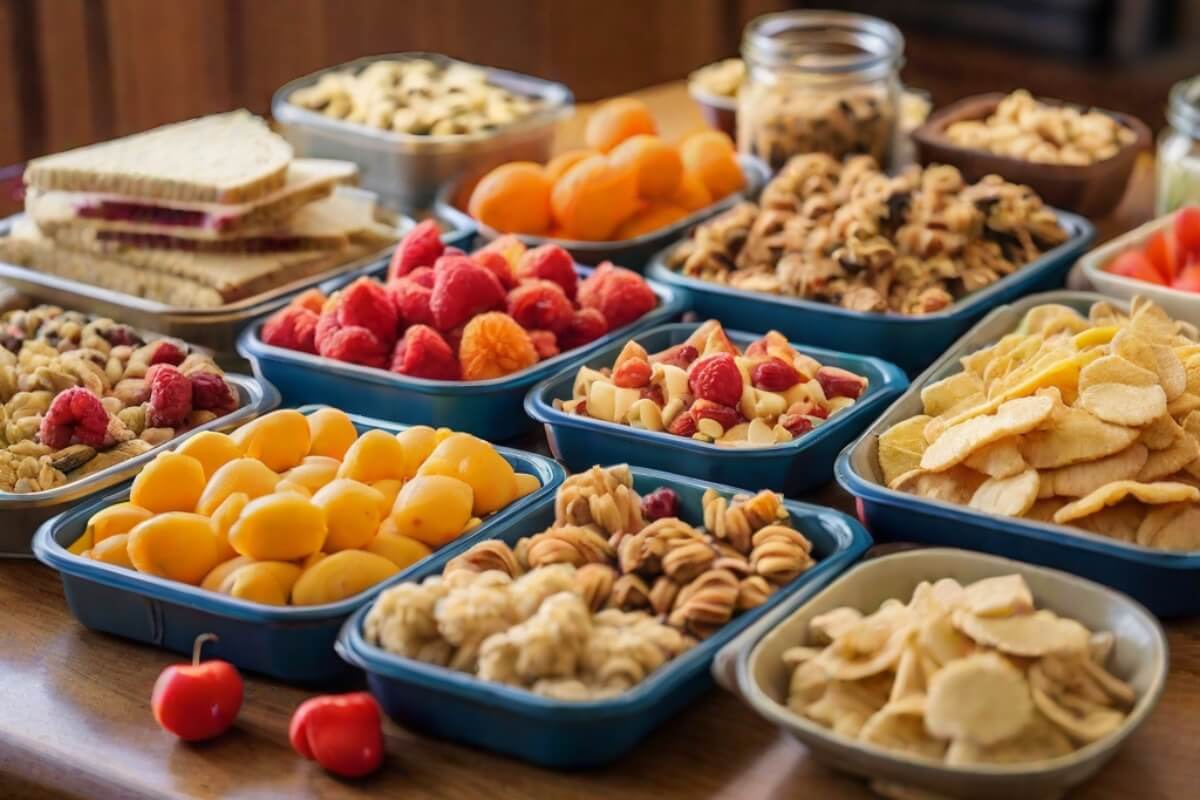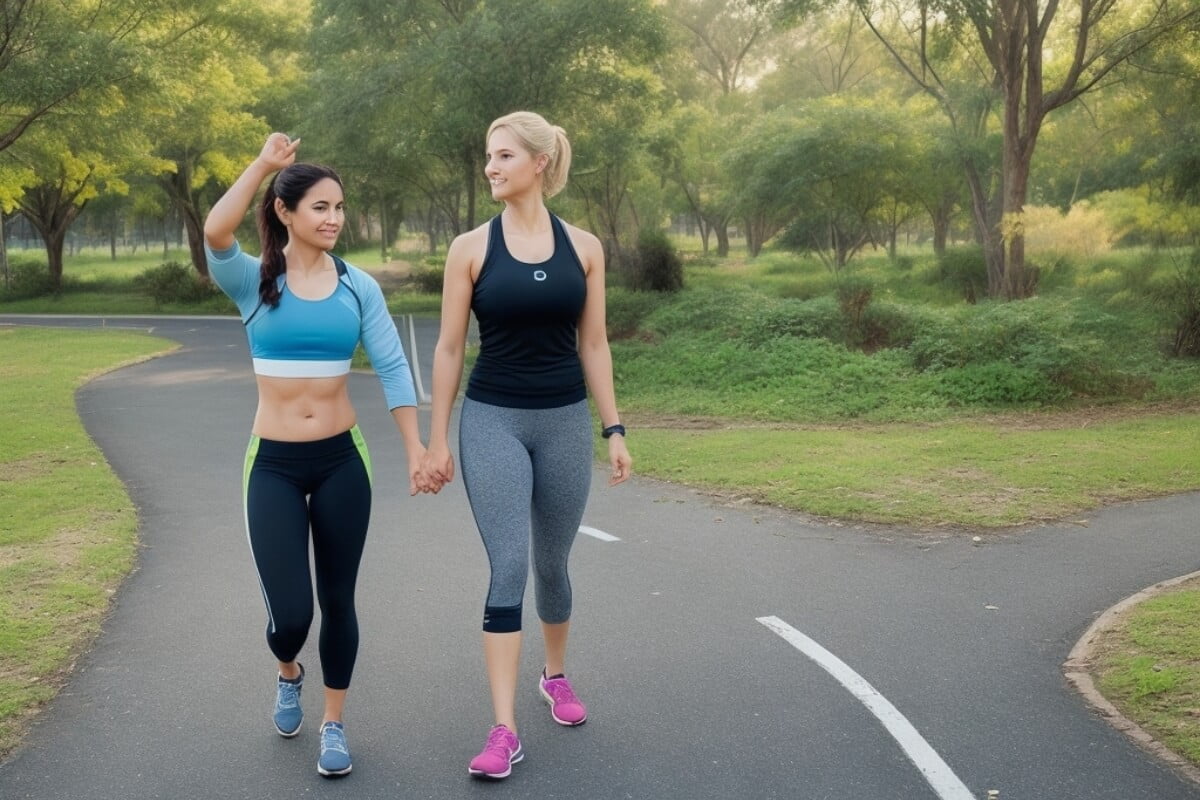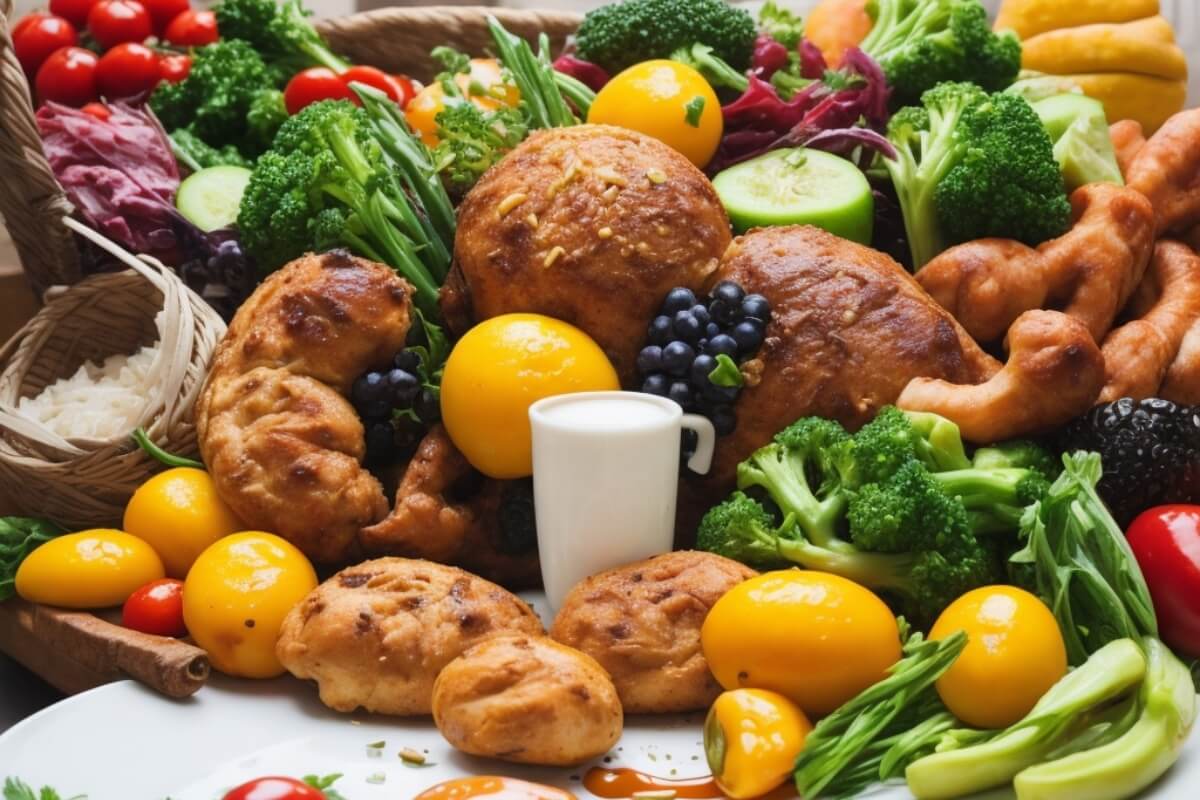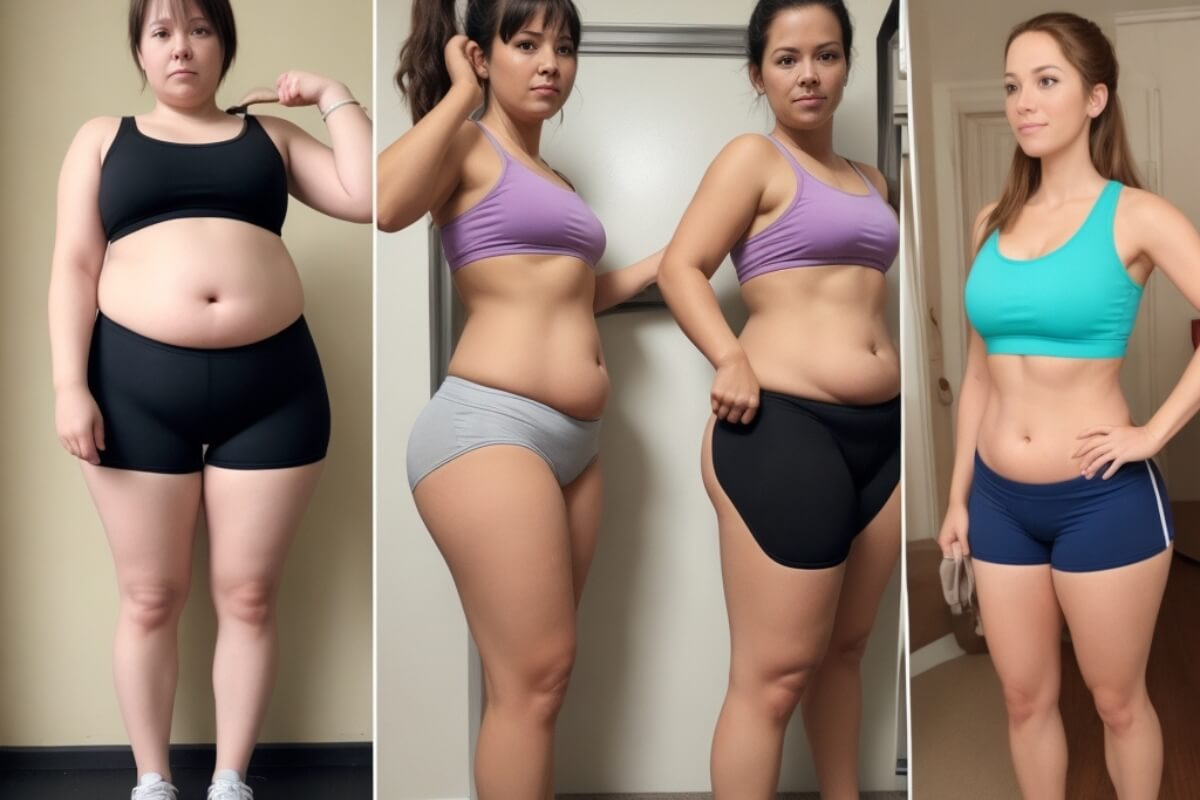Losing weight can be a challenge for many women, especially as they get older and face hormonal changes, stress, and busy lifestyles. However, there are some simple and effective ways to shed those extra pounds and improve your health and well-being.
In this article, we will share 20 of the best weight loss tips for women, based on scientific evidence and expert advice. Whether you want to lose a few kilos or make a major transformation, these tips can help you reach your goals and feel more confident and energetic.
Discover How This Simple “Meal Plan” Changes My Life Watch the video below to see if this effortless “Way Of Eating” will work for you…
How I Lost 10 Kilos in 3 Months
Before we dive into the tips, let me tell you a little bit about my own weight loss journey. I have always struggled with my weight, ever since I was a teenager. I tried many diets and exercise programs, but nothing seemed to work for me. I would lose some weight, but then gain it back as soon as I stopped following the plan. I felt frustrated and hopeless, and I hated the way I looked in the mirror.
Then, one day, I decided to make a change. I realized that I needed to adopt a new lifestyle, not just a temporary fix. I started to research the best ways to lose weight and keep it off, and I came across some of the tips that I will share with you in this article. I decided to give them a try, and I was amazed by the results. In just three months, I lost 10 kilos, and I felt healthier, happier, and more confident than ever. I also noticed that I had more energy, better sleep, and less cravings. I was able to fit into clothes that I hadn’t worn in years, and I received many compliments from my friends and family.
How did I do it? Well, it wasn’t easy, but it wasn’t impossible either. I followed some simple principles that helped me change my habits and mindset. I didn’t starve myself, or deprive myself of the foods that I loved. I just learned how to eat smarter, move more, and manage my stress. I also used some tools and apps that helped me track my progress and stay motivated. In the next sections, I will explain how you can do the same, and achieve your own weight loss success.
The Best Weight Loss Tips for Women
Here are 20 of the best weight loss tips for women, based on science and experience. You don’t have to follow all of them, but try to incorporate as many as you can into your daily routine. You will soon notice the difference, not only in your weight, but also in your overall health and happiness.
1. Eat more protein

Protein is one of the most important nutrients for weight loss. It helps you feel full, reduces your appetite, and boosts your metabolism. It also helps you preserve your muscle mass, which is essential for burning calories and maintaining your shape. Studies show that increasing your protein intake can help you lose weight and fat, especially around your belly ( 9, 10, 11 ).
How much protein do you need? The recommended daily intake for women is 0.8 grams per kilogram of body weight, but you may need more if you are active or trying to lose weight. Aim for at least 1.2 grams per kilogram, or about 20 to 30 grams per meal ( 12 ). Some of the best sources of protein are lean meats, poultry, fish, eggs, dairy, legumes, nuts, and seeds. You can also use protein powders or bars to supplement your intake, but make sure they are low in sugar and additives.
2. Fill up on fiber

Fiber is another key nutrient for weight loss. It helps you feel full, slows down the digestion of carbohydrates, and feeds the beneficial bacteria in your gut. It also helps lower your cholesterol, blood sugar, and blood pressure levels, and reduces your risk of various diseases ( 13, 14, 15 ). Studies show that eating more fiber can help you lose weight and fat, especially if you increase your intake of soluble fiber, which forms a gel-like substance in your stomach and intestines ( 16, 17 ).
How much fiber do you need? The recommended daily intake for women is 25 grams, but you may need more if you are trying to lose weight. Aim for at least 30 grams, or about 10 to 15 grams per meal ( 18 ). Some of the best sources of fiber are fruits, vegetables, whole grains, legumes, nuts, and seeds. You can also use fiber supplements, such as psyllium husk or glucomannan, to increase your intake, but make sure you drink plenty of water with them.
3. Drink more water

Water is essential for your health and weight loss. It helps you stay hydrated, flush out toxins, and regulate your body temperature. It also helps you feel full, and may increase the number of calories you burn at rest. Studies show that drinking more water can help you lose weight and fat, especially if you drink it before meals or replace sugary drinks with it ( 6, 7, 8 ).
How much water do you need? The general recommendation is to drink at least 2 liters, or 8 glasses, of water per day, but you may need more depending on your activity level, climate, and body size. A good way to check your hydration status is to look at the color of your urine. It should be clear or pale yellow, not dark or cloudy. You can also use apps or bottles that remind you to drink water throughout the day.
4. Cut down on refined carbs and added sugar

Refined carbs and added sugar are the enemies of weight loss. They are highly processed, low in nutrients, and high in calories. They spike your blood sugar levels, increase your hunger, and promote fat storage. They also increase your risk of diabetes, heart disease, and other chronic conditions ( 1, 2, 3 ). Studies show that reducing your intake of refined carbs and added sugar can help you lose weight and fat, especially around your belly ( 19, 20, 21 ).
How much refined carbs and added sugar do you need? The answer is: as little as possible. The World Health Organization recommends limiting your intake of added sugar to less than 10% of your total calories, or about 50 grams, or 12 teaspoons, per day. However, you may benefit from cutting it even further, to less than 5%, or 25 grams, or 6 teaspoons, per day ( 22 ). As for refined carbs, try to avoid or limit foods like white bread, pasta, rice, cereals, pastries, cookies, cakes, candy, soda, and juice. Instead, choose foods that contain complex carbs, such as fruits, vegetables, whole grains, legumes, nuts, and seeds. These foods are rich in fiber, vitamins, minerals, and antioxidants, and will keep you satisfied and energized for longer.
5. Eat more healthy fats

Fats are not the enemy of weight loss, as long as you choose the right ones. Healthy fats, such as monounsaturated and polyunsaturated fats, can help you feel full, lower your cholesterol, and improve your heart health. They can also help you lose weight and fat, especially if you replace some of the refined carbs and added sugar in your diet with them ( 23, 24, 25 ). Studies show that eating more healthy fats can help you lose weight and fat, especially around your belly ( 26, 27, 28 ).
How much healthy fats do you need? The recommended daily intake for women is 20 to 35% of your total calories, or about 44 to 78 grams, or 9 to 16 teaspoons, per day. However, you may need more or less depending on your goals, activity level, and health status. Some of the best sources of healthy fats are olive oil, avocado, nuts, seeds, fatty fish, and eggs. You can also use supplements, such as fish oil or flaxseed oil, to increase your intake, but make sure they are high quality and free of contaminants.
6. Use an app or food journal

One of the best ways to lose weight is to track your food intake. This can help you become more aware of what, when, and how much you eat, and identify any patterns or triggers that may be sabotaging your efforts. It can also help you plan your meals and snacks, and monitor your progress and achievements. Studies show that tracking your food intake can help you lose weight and keep it off, especially if you use an app or online tool that provides feedback and support ( 29, 30, 31 ).
How to track your food intake? There are many apps and websites that can help you track your food intake, such as MyFitnessPal, Cronometer, FatSecret, and Lose It! (see the previous section for more details). You can also use a simple notebook or diary, or take pictures of your food. The most important thing is to be consistent and honest, and record everything you eat and drink, including the portion sizes, calories, and nutrients. You can also track other factors, such as your mood, hunger, and cravings, and how they affect your food choices.
7. Eat more mindfully

Mindful eating is a practice that involves paying attention to your food and your body, and eating with intention and awareness. It can help you enjoy your food more, savor the flavors and textures, and appreciate the nourishment it provides. It can also help you eat less, control your portions, and avoid overeating or bingeing. Studies show that eating more mindfully can help you lose weight and improve your eating behaviors and attitudes ( 32, 33, 34 ).
How to eat more mindfully? There are some simple steps that can help you eat more mindfully, such as:
- Eating without distractions, such as TV, phone, or computer.
- Eating slowly and chewing well, paying attention to the sensations of taste, smell, texture, and temperature.
- Eating only when you are hungry, and stopping when you are full, listening to your body’s signals.
- Eating with gratitude, acknowledging the source and value of your food.
- Eating with pleasure, choosing foods that you enjoy and that make you feel good.
You can also use some techniques, such as meditation, breathing exercises, or guided imagery, to enhance your mindfulness and reduce stress.
8. Plan your meals and snacks

Planning your meals and snacks can help you lose weight by making sure you have healthy and balanced options available, and avoiding impulsive or unhealthy choices. It can also help you save time, money, and resources, and reduce food waste. Studies show that planning your meals and snacks can help you lose weight and improve your diet quality ( 35, 36, 37 ).
How to plan your meals and snacks? There are some tips that can help you plan your meals and snacks, such as:
- Setting a regular schedule for your meals and snacks, and sticking to it.
- Making a list of the foods and ingredients that you need, and shopping accordingly.
- Preparing your meals and snacks in advance, and storing them in containers or bags.
- Using apps or websites that can help you create and follow a meal plan, such as Eat This Much, PlateJoy, or Mealime (see the previous section for more details).
- Having some healthy and convenient options on hand, such as fruits, nuts, yogurt, or hard-boiled eggs, for when you need a quick bite.
9. Cook more at home

Cooking more at home can help you lose weight by giving you more control over what and how much you eat, and allowing you to use healthier and fresher ingredients. It can also help you save money, improve your skills, and enjoy your food more. Studies show that cooking more at home can help you lose weight and reduce your risk of obesity, diabetes, and heart disease ( 38, 39, 40 ).
How to cook more at home? There are some tips that can help you cook more at home, such as:
- Finding recipes that suit your taste, budget, and time, and trying new cuisines and dishes.
- Using simple and healthy cooking methods, such as baking, roasting, steaming, or grilling, and avoiding frying, deep-frying, or microwaving.
- Using herbs, spices, lemon, vinegar, or salsa to add flavor and variety to your food, and avoiding salt, sugar, or sauces.
- Using measuring cups, spoons, or scales to portion your food, and serving it on smaller plates or bowls.
- Inviting your family or friends to join you, and making cooking and eating a fun and social activity.
10. Eat more vegetables and fruits

Vegetables and fruits are some of the best foods for weight loss. They are low in calories, high in fiber, water, vitamins, minerals, and antioxidants, and can help you feel full and satisfied. They can also help prevent or treat various diseases, such as cancer, diabetes, and heart disease ( 41, 42, 43 ). Studies show that eating more vegetables and fruits can help you lose weight and fat, especially if you increase your intake of non-starchy vegetables, such as leafy greens, broccoli, cauliflower, or carrots ( 44, 45, 46 ).
How much vegetables and fruits do you need? The recommended daily intake for women is at least 400 grams, or 5 servings, of vegetables and fruits per day, but you may need more if you are trying to lose weight. Aim for at least 600 grams, or 8 servings, of vegetables and fruits per day, or about 150 grams, or 2 servings, per meal ( 47 ). Some of the best vegetables and fruits for weight loss are berries, apples, grapefruit, oranges, kiwi, watermelon, cucumber, celery, lettuce, spinach, kale, cabbage, Brussels sprouts, and mushrooms. You can also use smoothies, juices, or salads to increase your intake, but make sure they are low in sugar and additives.
11. Limit your alcohol intake

Alcohol can be a major obstacle for weight loss. It is high in calories, low in nutrients, and can impair your judgment and willpower. It can also increase your appetite, lower your metabolism, and promote fat storage, especially around your belly. It can also affect your sleep, mood, and health, and increase your risk of various diseases, such as liver disease, cancer, and depression ( 48, 49, 50 ). Studies show that limiting your alcohol intake can help you lose weight and fat, especially if you drink a lot or binge drink ( 51, 52, 53 ).
How much alcohol do you need? The answer is: as little as possible. The World Health Organization recommends limiting your alcohol intake to less than 10% of your total calories, or about 14 grams, or 1.5 units, per day for women. However, you may benefit from cutting it even further, to less than 5%, or 7 grams, or 0.75 units, per day, or avoiding it altogether ( 54 ). Some of the best ways to limit your alcohol intake are:
- Choosing low-alcohol or alcohol-free drinks, such as light beer, wine spritzer, or mocktail.
- Diluting your drinks with water, ice, or soda, and drinking slowly and moderately.
- Alternating your drinks with water, and staying hydrated throughout the day.
- Setting a limit for yourself, and sticking to it, or having a designated driver or buddy to help you.
- Avoiding drinking on an empty stomach, and eating a healthy meal or snack before or while you drink.
- Avoiding drinking as a coping mechanism, and finding other ways to deal with stress, boredom, or emotions.
12. Get enough sleep

Sleep is crucial for your weight loss. It helps you regulate your hormones, appetite, and metabolism. It also helps you recover from your workouts, and improve your mood and cognitive function. Studies show that getting enough sleep can help you lose weight and fat, especially if you sleep for at least 7 hours per night, and have a regular and consistent sleep schedule ( 55, 56, 57 ).
How much sleep do you need? The recommended amount of sleep for women is 7 to 9 hours per night, but you may need more or less depending on your age, lifestyle, and health status. Some of the best ways to get enough sleep are:
- Setting a regular bedtime and wake-up time, and sticking to them, even on weekends and holidays.
- Creating a comfortable and relaxing sleep environment, with a dark, quiet, and cool room, and a comfortable bed, pillow, and blanket.
- Avoiding caffeine, alcohol, nicotine, or heavy meals before bed, as they can interfere with your sleep quality and quantity.
- Avoiding screens, such as TV, phone, or computer, at least an hour before bed, as they can emit blue light that can disrupt your circadian rhythm and melatonin production.
- Engaging in relaxing activities, such as reading, listening to music, meditating, or breathing exercises, before bed, to calm your mind and body.
- Avoiding naps during the day, especially in the afternoon or evening, as they can affect your sleep cycle and make it harder to fall asleep at night.
13. Move more throughout the day

Moving more throughout the day can help you lose weight by increasing your physical activity and burning more calories. It can also help you improve your cardiovascular, muscular, and joint health, and prevent or reduce the risk of various diseases, such as diabetes, heart disease, and osteoporosis. Studies show that moving more throughout the day can help you lose weight and fat, especially if you increase your non-exercise activity thermogenesis (NEAT), which is the energy you expend for activities other than sleeping, eating, or exercising ( 58, 59, 60 ).
How to move more throughout the day? There are some tips that can help you move more throughout the day, such as:
- Taking the stairs instead of the elevator or escalator, and walking or cycling instead of driving or taking public transport, whenever possible.
- Parking your car further away from your destination, and walking the rest of the way, or getting off the bus or train one or two stops earlier, and walking the rest of the way.
- Standing up and stretching every hour, and taking breaks from sitting, especially if you work at a desk or computer.
- Walking or jogging around your neighborhood, or doing some household chores, during your lunch break or after dinner.
- Using a fitness tracker, app, or pedometer to monitor your steps, and setting a daily goal of at least 10,000 steps, or 30 minutes of moderate activity.
- Joining a walking, hiking, or cycling club, or finding a friend or family member to join you, and making it a fun and social activity.
14. Exercise regularly

Exercise is one of the best ways to lose weight and keep it off. It helps you burn calories, build muscle, and boost your metabolism. It also helps you improve your physical and mental health, and prevent or treat various diseases, such as diabetes, heart disease, and depression. Studies show that exercising regularly can help you lose weight and fat, especially if you do a combination of aerobic and resistance training, and increase the intensity, duration, and frequency of your workouts ( 61, 62, 63 ).
How much exercise do you need? The recommended amount of exercise for women is at least 150 minutes of moderate-intensity, or 75 minutes of vigorous-intensity, aerobic activity per week, plus at least two sessions of resistance training that target all the major muscle groups per week. However, you may need more if you are trying to lose weight. Aim for at least 300 minutes of moderate-intensity, or 150 minutes of vigorous-intensity, aerobic activity per week, plus at least three sessions of resistance training that target all the major muscle groups per week ( 64 ). Some of the best exercises for weight loss are:
- Aerobic exercises, such as running, swimming, cycling, or dancing, that raise your heart rate and make you breathe harder.
- Resistance exercises, such as lifting weights, doing bodyweight exercises, or using resistance bands, that challenge your muscles and make them stronger and firmer.
- High-intensity interval training (HIIT), which involves alternating short bursts of intense activity with longer periods of rest or low-intensity activity, that can increase your calorie burn and fat loss.
- Circuit training, which involves doing a series of different exercises with little or no rest in between, that can improve your cardiovascular and muscular endurance and strength.
- Functional training, which involves doing exercises that mimic the movements you do in your daily life, such as squatting, lunging, pushing, pulling, or twisting, that can improve your balance, coordination, and mobility.
15. Find a workout that you enjoy

Finding a workout that you enjoy can help you lose weight by making exercise more fun and motivating, and less of a chore. It can also help you stick to your routine, and avoid boredom or burnout. Studies show that finding a workout that you enjoy can help you lose weight and keep it off, especially if you choose an activity that suits your personality, preferences, and goals ( 65, 66, 67 ).
How to find a workout that you enjoy? There are some tips that can help you find a workout that you enjoy, such as:
- Trying different types of exercises, such as yoga, pilates, boxing, or martial arts, and finding one that matches your interests and abilities.
- Joining a class, group, or club, or finding a trainer, coach, or instructor, that can teach you new skills, provide feedback, and offer support and encouragement.
- Listening to music, podcasts, or audiobooks, or watching TV, videos, or movies, while you exercise, to keep you entertained and distracted.
- Setting realistic and specific goals, and tracking your progress and achievements, to keep you motivated and challenged.
- Rewarding yourself with something that you like, such as a massage, a movie, or a new outfit, when you reach your goals, to keep you satisfied and happy.
16. Vary your workouts

Varying your workouts can help you lose weight by preventing your body and mind from adapting to the same routine, and challenging them in different ways. It can also help you avoid plateaus, injuries, and boredom, and improve your performance and results. Studies show that varying your workouts can help you lose weight and fat, especially if you change the type, intensity, duration, or frequency of your exercises ( 68, 69, 70 ).
How to vary your workouts? There are some tips that can help you vary your workouts, such as:
- Changing the type of exercise you do, such as switching from running to swimming, or from lifting weights to doing bodyweight exercises, every few weeks or months.
- Changing the intensity of your exercise, such as increasing the speed, resistance, or incline, or adding intervals, hills, or sprints, every few sessions or days.
- Changing the duration of your exercise, such as increasing or decreasing the time you spend on each exercise, or doing more or fewer sets or reps, every few sessions or days.
- Changing the frequency of your exercise, such as increasing or decreasing the number of times you exercise per week, or doing more or fewer rest days, every few weeks or months.
- Changing the order of your exercises, such as doing them in a different sequence, or alternating between upper and lower body, or between aerobic and anaerobic, every few sessions or days.
17. Eat breakfast

Eating breakfast can help you lose weight by kick-starting your metabolism, and providing you with energy and nutrients for the day. It can also help you control your appetite, and prevent you from overeating or snacking later in the day. Studies show that eating breakfast can help you lose weight and fat, especially if you eat a high-protein, high-fiber, and low-sugar breakfast ( 71, 72, 73 ).
How to eat breakfast? There are some tips that can help you eat breakfast, such as:
- Eating within an hour of waking up, and not skipping breakfast, even if you are not hungry or in a hurry.
- Choosing a breakfast that contains at least 20 grams of protein, 5 grams of fiber, and less than 10 grams of added sugar, and that is balanced and satisfying.
- Some of the best breakfast foods for weight loss are eggs, oatmeal, yogurt, cottage cheese, quinoa, nuts, seeds, fruits, and vegetables. You can also use smoothies, shakes, or bars to increase your intake, but make sure they are low in sugar and additives.
- Avoiding breakfast foods that are high in calories, fat, salt, or sugar, such as bacon, sausage, croissant, muffin, donut, cereal, or juice. These foods can spike your blood sugar, increase your hunger, and promote fat storage.
18. Eat more frequently

Eating more frequently can help you lose weight by keeping your metabolism and blood sugar levels stable, and preventing you from getting too hungry or overeating. It can also help you improve your digestion, and provide you with a steady supply of energy and nutrients throughout the day. Studies show that eating more frequently can help you lose weight and fat, especially if you eat 4 to 6 smaller meals or snacks per day, instead of 2 or 3 larger ones ( 74, 75, 76 ).
How to eat more frequently? There are some tips that can help you eat more frequently, such as:
- Eating every 3 to 4 hours, and not going longer than 5 hours without eating, even if you are not hungry or busy.
- Choosing meals and snacks that contain a combination of protein, fiber, healthy fats, and complex carbs, and that are balanced and satisfying.
- Some of the best foods for frequent eating are nuts, seeds, fruits, vegetables, hummus, cheese, yogurt, eggs, tuna, chicken, turkey, or beef. You can also use bars, shakes, or soups to increase your intake, but make sure they are low in sugar and additives.
- Avoiding foods that are high in calories, fat, salt, or sugar, such as chips, cookies, candy, soda, or juice. These foods can spike your blood sugar, increase your hunger, and promote fat storage.
19. Eat less at night

Eating less at night can help you lose weight by reducing your total calorie intake, and allowing your body to burn more fat while you sleep. It can also help you improve your sleep quality and quantity, and prevent or reduce the risk of various diseases, such as diabetes, heart disease, and cancer. Studies show that eating less at night can help you lose weight and fat, especially if you eat your last meal at least 3 hours before bed, and limit your intake of carbs and calories at night ( 77, 78, 79 ).
How to eat less at night? There are some tips that can help you eat less at night, such as:
- Eating a light and early dinner, and avoiding heavy or spicy foods, or large portions, that can cause indigestion, heartburn, or bloating.
- Choosing a dinner that contains at least 20 grams of protein, 5 grams of fiber, and less than 30 grams of carbs, and that is balanced and satisfying.
- Some of the best foods for dinner are fish, chicken, turkey, tofu, eggs, salad, soup, or stir-fry. You can also use wraps, sandwiches, or bowls to increase your intake, but make sure they are low in sugar and additives.
- Avoiding snacks or desserts after dinner, and drinking water, tea, or milk, instead of alcohol, soda, or juice. If you are hungry, you can have a small and healthy snack, such as a piece of fruit, a handful of nuts, or a cup of yogurt, but not too close to bedtime.
20. Be consistent and patient

The last and most important tip for weight loss is to be consistent and patient. Weight loss is not a quick or easy process, but a long-term and gradual one. It requires dedication, discipline, and perseverance, and it may involve some setbacks, challenges, and frustrations. However, if you stick to your plan, and follow the tips that we have shared with you in this article, you will eventually see the results that you want, and achieve your goals. Studies show that being consistent and patient can help you lose weight and keep it off, especially if you adopt a realistic and sustainable lifestyle, and not a drastic or temporary diet ( 80, 81, 82 ).
How to be consistent and patient? There are some tips that can help you be consistent and patient, such as:
- Setting realistic and specific goals, and breaking them down into smaller and measurable steps, that you can track and celebrate.
- Finding a support system, such as a friend, family member, trainer, coach, or group, that can motivate you, encourage you, and hold you accountable.
- Learning from your mistakes, and not giving up or feeling guilty, when you slip up or face obstacles, but rather getting back on track and moving forward.
- Focusing on the positive aspects, and not the negative ones, of your weight loss journey, and recognizing the benefits and improvements that you have made, not only in your weight, but also in your health and happiness.
- Rewarding yourself with something that you like, such as a massage, a movie, or a new outfit, when you reach your milestones, but not with food or drink, that can undo your efforts.
Conclusion
In this article, we have shared with you 20 of the best weight loss tips for women, based on scientific evidence and expert advice. These tips can help you lose weight and fat, and improve your health and well-being, if you follow them consistently and patiently. We hope that you have found this article useful and informative, and that you will apply some or all of these tips to your own weight loss journey. We also invite you to share your feedback, opinions, and suggestions with us, and let us know how these tips have worked for you. Thank you for reading, and good luck!
Now that you’ve learned the 20 best tips for losing weight in 3 months, to keep your body in shape I’m going to show you the 30 easy keto diet recipes for breakfast, lunch, and dinner so you’ll never go hungry again, without having to stop eating delicious and nutritious food see here.
Follow our social networks facebook, pinterest and see more tips
